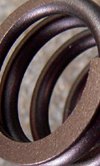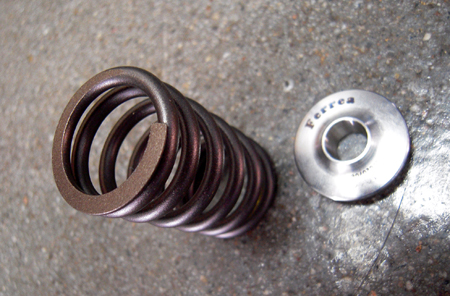Small springs that do the job
 Working with a production engine and increasing the stroke on it can often lead to problems in the valvetrain. That hasn't been the case for Rhys Millen Motorsports (RMR), who decided - with four months to spare - that it would build up a Hyundai Lambda V6 from 3.8 to nearly 4.1 litres and install a single turbocharger for the 2010 Pikes Peak Hillclimb.
Working with a production engine and increasing the stroke on it can often lead to problems in the valvetrain. That hasn't been the case for Rhys Millen Motorsports (RMR), who decided - with four months to spare - that it would build up a Hyundai Lambda V6 from 3.8 to nearly 4.1 litres and install a single turbocharger for the 2010 Pikes Peak Hillclimb.
By the time the engine was completed it developed 698 hp and 670 lb-ft of torque. "When we were running the stock engine with a higher boost, we noticed the valves were getting tweaked a little here and there, but what do you expect with a stock unit putting out that kind of horsepower?" says team manager Eric Cantore. The Lambda V6 normally produces about 300 hp but, says Cantore, "We've doubled that and then some."
Even with the original equipment engine, RMR found very little wear on the valve springs. "We were pretty much using all the elasticity available. We basically went back to that very soft material and the valves were starting to wander a bit [when the engine was upgraded]," Cantore says.
Still using a stock valvetrain, RMR needed to get the right valve spring for its larger capacity engine. Cantore called Ferrea Racing Components of Fort Lauderdale, Florida, for advice. "They said they could make things a bit lighter and stronger, and gave us a different set of springs. We tried it out, ran it for three events, took the head down and checked the springs, and everything was right back to new," Cantore says.
"Spring pressure was at the same 180 pounds spring rate - the stock springs are 80 pounds. The springs retain pressure throughout and the retainers are beautiful. The valves are straight with no pinging on them; we use a solid valve, not hollow material. Ferrea have been able to bring in materials that are almost as light as titanium but without the cost and any further worries," Cantore says.
Because this is a turbocharged application, the exhaust side retains heat, so RMR uses a spring developed from high-strength alloys, focusing on premium-grade chrome silicon steel. The springs are heat-treated and stress relieved to increase spring life. "We're still using a high-strength alloy - a silicon steel - but we expect to work with a tool steel mixed with different alloys once it's tested," Cantore says.

The 30 gramme valve spring is a single spring with titanium retainer that is CNC machined from aerospace-quality titanium. The retainers are heat-treated as well.
"We only rev the engine to about 7600 rpm, which is not very high. It doesn't need to be because we see our power start to taper off at about 7200, so a larger spring isn't necessary," Cantore says, adding that they've had no problems with the small, single spring and that the valves look good after each use.
The team does leakdown and pressure checks after every event and used these springs for five contests, including a Brazilian hillclimb last December. They intend to refresh all valvetrain equipment before the first Formula Drift event at Long Beach, California, in April.
The springs have a flat top with a bucket tappet and shim underneath. "We gave Ferrea a cylinder head and they went and cut the valves, floated it and told us what would be best for our application," Cantore says. "The valve spring worked great at Pikes Peak and in all of our Formula Drift events."
The valve springs are of equal size for intake and exhaust. "With the lower revs they don't see any spring pressure loss," Cantore says.
Fig. 1 - Ferrea valve spring and retainer (Photo: Anne Proffit)
Written by Anne Proffit